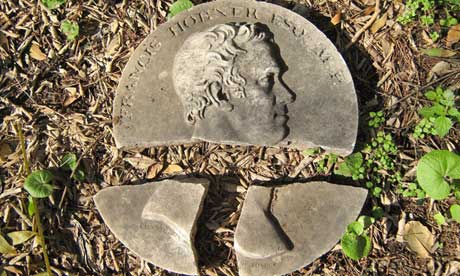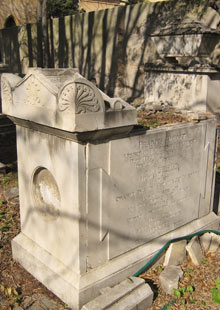Italians unveil long-lost tomb medallion of Scottish MP
Profile of Francis Horner created by regency sculptor Sir Francis Chantrey is found by volunteers at Livorno cemetery
Lizzy Davies in Livorno
The Guardian, Saturday 18 May 2013

Sir Francis Chantrey's medallion portrait of Francis Horner found at the Protestant cemetery in Livorno.
Amid rampant weeds and crumbling stones, Matteo Giunti makes his way to the tomb of Francis Horner MP, a Scottish Whig who co-founded the Edinburgh Review and died, in 1817, in what he would have known as the prosperous Tuscan port of Leghorn.
But, as he reaches the once imposing grave, Giunti stops first at the Nike trainer and plastic bottle that have been left there overnight – not, presumably, by well-wishers. "This is nothing," he says. "People throw trash over the walls. We've found bicycles. We've found wheels. We've found all sorts of things."

Francis Horner's damaged tomb.
In March last year, as he and fellow volunteer Francesco Ceccarini were scrabbling through the m&d and vegetation on the top of Horner's dilapidated tomb in the city's old English cemetery, they stumbled on something whose significance was not immediately apparent. A piece of stone, broken into three and caked in dirt, it was barely recognisable. But, after some research and more thought, the penny dropped. They had, Giunti realised, found the long-lost medallion that had once graced the tomb: a profile of Horner in bas relief carved by the foremost sculptor of Regency Britain, Sir Francis Chantrey. "When I understood what it was," he says, "we decided, 'Wow, this is something – we need to take it away from here.'"
Unveiled on Friday before journalists and locals in the Museo Fattori, the sculpture represents vindication for the five locals who make up the cultural association Livorno delle Nazioni (LdN) and who have fought to reverse the decline of what they describe as Italy's oldest Protestant cemetery still in existence.
With its first marked grave dating from 1646 (a 21-year-old, Leonard Digges), Livorno's small corner of England has almost two centuries on its counterpart in Florence and is older even than Rome's. There are merchants and mothers; novelists and navy men; one of Byron's bankers and a favoured pupil of Mary Wollstonecraft.
After wartime bombing and decades of neglect, however, many tombstones lie cracked and dirty. And the cemetery's aesthetic appeal is marred by the large car park that opened last year next door. The cemetery has been run for decades by the Misericordia, a charity which also runs an ambulance service. In 2011, the LdN was set up to formalise the efforts of Giunti and his fellow volunteers, who have tried to step up the cleaning, gardening and research that is needed if the place is to be returned to its former glory.
Now, the LdN hopes that the discovery of the Chantrey could help to attract attention – and money. "I'm pretty confident that this could be a real treasure. It's something that just needs more organisation and funding," says Lisa Lillie, Giunti's American wife. Among the hundreds of graves are those of Scottish writer Tobias Smollett, Irish aristocrat Margaret King – taught by Wollstonecraft and friend to her daughter, Mary Shelley – and the English merchant Robert Bateman. The cemetery was closed in the mid-19th century.
What will become of Chantrey's long-lost work is unclear. It must first be restored, then a decision taken on whether to put it back on Horner's tomb or in a Livorno museum. "I feel that someone would steal it," Giunti says, rather despondently. "Even if it's difficult to sell it."
